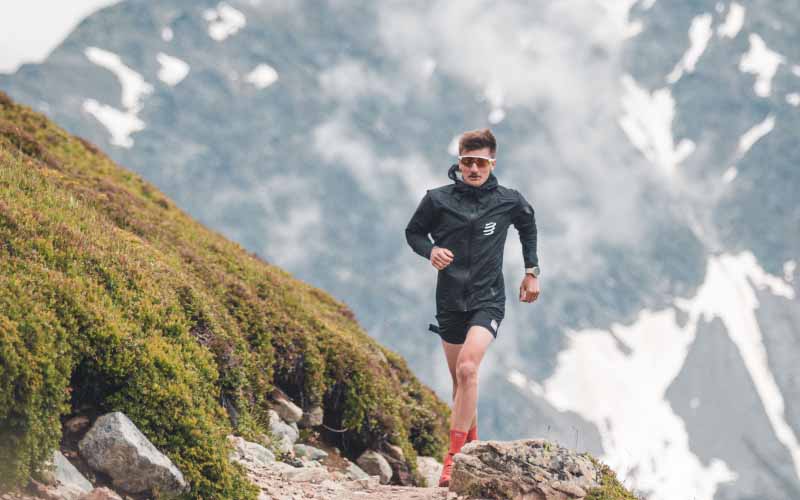
Embarking on trail running requires more than just lacing up your sneakers and hitting the road. This demanding discipline necessitates careful preparation, especially when tackling technical terrains or navigating the ups and downs of mountainous landscapes. Whether you’re a novice transitioning from flat or road running or an experienced trail enthusiast aiming to enhance your skills, understanding the principles of a trail running training plan is crucial.
Contents
Understanding the nuances of trail running
The crux of trail running lies in the challenges posed by varying altitudes and terrains. On mountain trails descents can be even more taxing on muscular strength than ascents. As you descend, muscles engage eccentrically, slowing down the descent and exerting additional strain. Even a descent of 300 to 400 meters can leave a lasting impact on your muscles, underscoring the importance of addressing this aspect in your training and trail running training plan. The longer the trail you plan to conquer, the more critical this muscular component becomes.
Trail running also demands logistical preparation. As you ascend in altitude, temperature drop, and weather conditions can change rapidly. Equipping yourself with appropriate equipment and carrying essentials like water and energy bars becomes paramount.
Components of an effective trail running training plan
Similar to road running, trail performance hinges on three key parameters: VO2max, running economy, and endurance. Additionally, muscular and mental stamina play pivotal roles in sustaining efforts over extended durations.
Fundamental endurance: the foundation of any trail running training plan lies in building fundamental endurance. Incorporating hike-run sessions over several hours, and or longer trails, engaging in 5-6 hour hike-run courses can be beneficial. Cross-training with biking can also help improve endurance while reducing impact on joints.
Intensity training: elevating your VO2max and refining running economy during uphill and downhill conditions involves fractional training on both short and long climbs. Including intensity sessions in your trail running training plan, focusing on climbs and occasionally descents, helps prepare for the varied demands of trail running.
Muscular resistance: strengthening muscles through targeted exercises, proprioception training, eccentric physical preparation, and endurance work on the bike contribute to overall muscular resistance.
Running and equipment management: training allows you to validate your choices of equipment, nutrition, and hydration (500 to 800mL of drink per hour). Gastric issues are the leading case of abandonment in trail running. Nothing should be left to chance. If you use poles on race day, use them regularly in training.
The importance of progression in trail running
In trail running, just like on flat terrain, progression is paramount. Launching into an ultra-trail in your first season is not advisable. It’s essential to validate certain stages, and ultra-trails should not be considered before completing 2 to 3 successful trail seasons. Each format has its own specificities and brings its own joys.
In training, progression is equally crucial. The initial outings in your trail running training plan should start with 200m to 400m of elevation gain before increasing the altitude difference. Your muscle fibers will thank you!
Considering the elevation in the mountains
The race profile should be taken into account in your preparation. A race may have a 1000m positive elevation gain and cover only 4 kilometers – this is known as a vertical kilometer. If your race is 20 or 30 kilometers long, those 1000m of elevation gain will be more gradual.
The lower the elevation/distance ration the more significant the speed component becomes. In such cases, it’s crucial to focus on refining your stride and the ability to maintain moderate paces over long distances. This is also applicable to longer races with a low elevation/distance ratio.
Depending on the race, you might encounter technical terrains with stones, rocks, roots, or other challenging sections. If your race includes such elements, make it a regular part of your training. The same applies if you’re running at night.
Your personalized trail running training plan should also consider your training terrains. If you reside in a city, you can find ways to strengthen your thighs. Whether it’s hitting the gym, using stairs, or incorporating short hill sessions, adapt your training to your environment.
Your trail running training plan in RunMotion Coach
Taking into account your training terrain, RunMotion Coach offers tailored trail running training plans that factor in various parameters. Our algorithms provide you with tailored training sessions, regardless of the distance you are preparing for. Every week, we guide you with a recommended elevation gain to achieve.
In the month leading up to your race, you will receive specific advice to arrive well-prepared for your trail objective. Now more than ever, focus on recovery and fine-tune details of your equipment and nutrition for the big day. One month before the rave, you can also do a reconnaissance of your course (all or part of it) to understand what to expect during the race. In the Premium version, you will also have access to physical and mental preparation.
Based in the Alps, RunMotion Coach collaborates with renewed trails such as the MaXi-Race, Trail de Haute Provence nFestival des Templiers, and is the official coach of the UTMB Mont-Blanc®. You are in good hands for your personalized trail running training plan!
Trail running is an exhilarating adventure that demands meticulous preparation. Whether you’re navigating steep descents, confronting technical terrains, or preparing for a specific race profile, a well-structured trail running training plan is your roadmap to success. So, lace up those trail running shoes, hit the trails, and let your personalized trail running training plan guide you to new heights. We look forward to seeing you conquer the trails! 😉